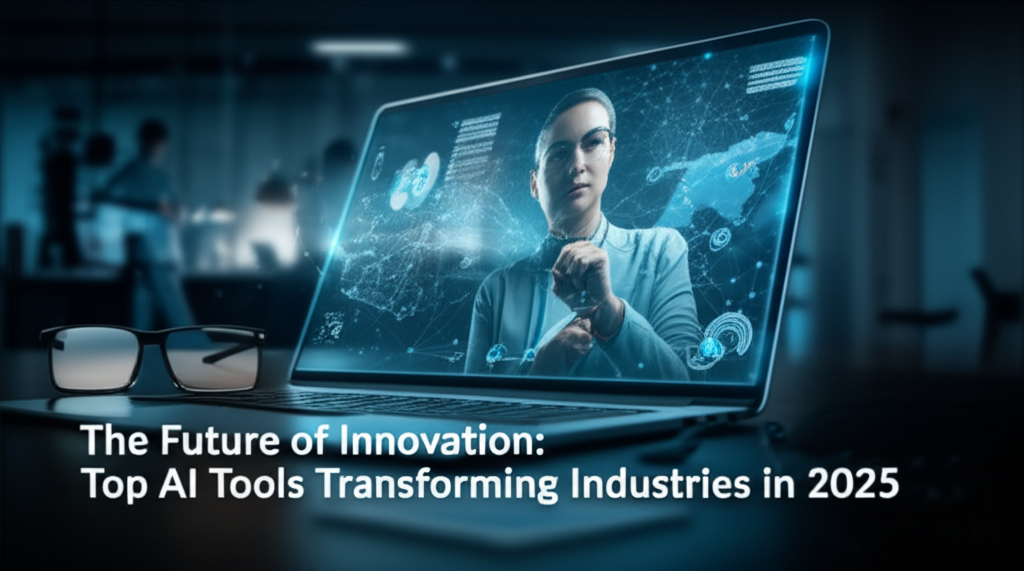Introduction
As we advance deeper into the 21st century, artificial intelligence (AI) is no longer just a concept from science fiction but a rapidly evolving reality. The year 2025 marks a significant milestone in AI development, transforming industries across the globe. From healthcare and finance to education and manufacturing, AI tools are reshaping how we conduct business and interact with technology. This article delves into the future of innovation, highlighting key AI tools expected to make a considerable impact by 2025.
1. The AI Landscape in 2025
Before we explore specific tools and their implications, it’s crucial to understand the landscape of AI in 2025. Technological advancements over the past few years have led to:
- Improved algorithms: Enhanced machine learning models provide more accurate predictions and better performance across various applications.
- Increased accessibility: More businesses, large and small, are adopting AI technologies, thanks to reduced costs and simplified integration processes.
- Ethical considerations: As AI becomes more prevalent, ethical implications regarding privacy, bias, and job displacement are at the forefront of discussions among leaders and policymakers.
Let’s examine some of the top AI tools projected to transform industries by 2025.
2. AI in Healthcare
2.1 AI-Powered Diagnostics
Tool: IBM Watson Health
IBM Watson Health, a robust AI tool, is set to revolutionize healthcare diagnostics by 2025. By utilizing natural language processing and machine learning, Watson can analyze vast amounts of medical data, including patient records and clinical literature. Its impact includes:
- Personalized treatment plans: By understanding individual genetic profiles and medical histories, Watson can tailor treatments to patients, rather than following a one-size-fits-all approach.
- Early detection of diseases: The tool’s ability to process data quickly may enable early diagnosis of conditions like cancer, significantly improving patient outcomes.
2.2 Drug Discovery and Development
Tool: Atomwise
Atomwise is transforming the pharmaceutical industry by using AI to predict how different molecules will interact with specific diseases. This tool is expected to:
- Accelerate drug discovery: By simulating biological interactions at a molecular level, Atomwise can identify potential drug candidates faster than traditional methods.
- Reduce costs: Lowering the cost and time associated with drug development will enable smaller companies to bring innovations to market more effectively.
3. AI in Finance
3.1 Automated Financial Advisors
Tool: Wealthfront
Wealthfront provides automated financial planning and investment services powered by AI. By 2025, we can expect:
- Personalization at Scale: Wealthfront can analyze user data in real-time to recommend customized investment strategies.
- Risk Management: AI algorithms can continuously assess market risks and suggest portfolio adjustments to optimize returns.
3.2 Fraud Detection
Tool: Kount
Kount uses AI to detect fraudulent transactions in real time. By leveraging machine learning, it predicts potential fraud based on historical transaction data. Its significance lies in:
- Faster response times: Immediate alerts allow businesses to act quickly against fraudulent activities.
- Improved customer trust: Enhanced security measures not only protect companies but also build trust with consumers.
4. AI in Education
4.1 Personalized Learning Platforms
Tool: DreamBox Learning
DreamBox Learning uses AI to provide personalized math education for K-8 students. Expected advancements by 2025 include:
- Adaptive learning experiences: The platform adjusts content based on individual learning paces and styles, ensuring better student engagement.
- Real-time feedback: Students receive immediate feedback, allowing them to correct mistakes and reinforce learning more effectively.
4.2 AI Tutors
Tool: Squirrel AI
Squirrel AI is an adaptive learning platform that serves as a virtual tutor. Looking ahead to 2025, we anticipate:
- Collaborative Learning: The tool helps students not only learn but also work collaboratively on group projects, enhancing critical thinking skills.
- Global Accessibility: AI-driven tutors can bridge educational gaps in underserved regions, making quality education accessible to all.
5. AI in Manufacturing
5.1 Predictive Maintenance
Tool: SparkCognition
SparkCognition’s AI tools analyze data from machinery to predict when maintenance is needed. This capability will:
- Minimize downtime: Early alerts about potential failures can help manufacturers schedule maintenance proactively, thus avoiding costly production halts.
- Enhance operational efficiency: Intelligent systems will make real-time adjustments to optimize equipment performance.
5.2 Supply Chain Optimization
Tool: Llamasoft
Llamasoft uses AI to provide insights into supply chain management. By 2025, we can expect it to:
- Improve decision-making: By analyzing vast data sets, Llamasoft helps manufacturers make informed decisions regarding inventory and logistics.
- Enhance agility: AI-driven insights will allow businesses to respond swiftly to market changes.
6. AI in Agriculture
6.1 Precision Farming
Tool: Granular
Granular is AI software designed for farmers, offering insights into farm management. Key future potentials include:
- Data-driven decisions: Farmers can leverage weather data, soil conditions, and crop performance analytics to make more informed choices.
- Resource management: Better optimization of water, fertilizers, and pesticides will lead to sustainable farming practices and reduced costs.
6.2 Crop Monitoring
Tool: Agribot
Agribot is an AI-powered robot equipped with sensors for monitoring crop health. By 2025, its capabilities may extend to:
- Early disease detection: Continuous monitoring will help farmers identify problems before they escalate, leading to healthier yields.
- Increased efficiency: Automating labor-intensive tasks will free up farmers to focus on strategic planning.
7. AI in Transportation
7.1 Autonomous Vehicles
Tool: Waymo
Waymo is expected to advance autonomous vehicle technology significantly by 2025. Developments may include:
- Enhanced safety: Continuous learning from real-world driving data will make autonomous vehicles safer.
- Reduced traffic congestion: Integrating AI with city infrastructure could optimize traffic flow, limiting gridlocks.
7.2 Logistics Optimization
Tool: OptimoRoute
OptimoRoute uses AI to plan delivery routes efficiently. The future of logistics involves:
- Real-time adjustments: AI can reroute deliveries based on traffic conditions or weather, maximizing efficiency.
- Cost savings: Optimized routes can lead to significant fuel and time savings for logistics companies.
8. AI in Retail
8.1 Inventory Management
Tool: Inventory Planner
This AI tool assists retail businesses in managing stock levels. By 2025, we can expect:
- Automated forecasting: Predictive analytics will help retailers manage stock more effectively according to demand.
- Reduced waste: Better inventory management can minimize overstock and understock situations, leading to increased profitability.
8.2 Personalized Shopping Experiences
Tool: Vue.ai
Vue.ai leverages customer data to offer personalization in e-commerce. Future impacts include:
- Enhanced customer engagement: Tailored product recommendations based on browsing history will improve user experiences.
- Visual search capabilities: AI-driven visual search will allow customers to find products more intuitively.
9. Cultural Implications of AI Innovation
9.1 Ethical Dimensions
As AI becomes increasingly integrated into various industries, ethical considerations will rise to prominence. Key areas to address include:
- Bias in AI: Algorithms can inadvertently reflect societal biases. Ensuring diverse data sets in training will be essential to mitigate this issue.
- Job displacement: Industries must prepare for the changes AI will bring to the job market. Reskilling and upskilling will become imperative in transitional phases.
9.2 Cultural Shift
The rise of AI tools will initiate a cultural shift, affecting how businesses operate and how consumers interact with services. Anticipated outcomes include:
- Greater transparency: Consumers will demand greater transparency regarding how their data is used, expect clearer communications from businesses.
- Collaborative work environments: As AI takes over more repetitive tasks, workers can shift focus to complex problem-solving and innovation.
10. Conclusion
By 2025, the landscape of industries transformed by AI tools will be profoundly different. The healthcare, finance, education, manufacturing, agriculture, transportation, and retail sectors will leverage these technologies to create more efficient, personalized, and sustainable systems. However, with innovation comes responsibility; businesses and policymakers must navigate the ethical considerations inherent in these advancements. As we venture into this new era of innovation, the collaboration between human ingenuity and AI promises to redefine productivity and redefine our daily lives.
This article serves as a glimpse into the future shaped by AI technologies, showcasing how diverse sectors are on the brink of transformation. The timeline for these innovations may vary, but the overarching trends are clear: AI will continue to break barriers, unlocking new possibilities for growth and efficiency across industries.

